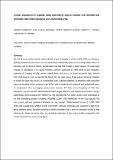Vulture populations in Uganda : using road survey data to measure both densities and encounter rates within protected and unprotected areas
Abstract
Six out of seven vulture species whose global ranges lie largely or wholly within Africa are listed as globally threatened. Since their current distributions individually span up to 39 range states there is a pressing need to develop robust, standardised methods that provide a clear measure of range-wide changes in abundance. Yet, survey methods currently used tend to yield either of two measures: estimates of breeding density, derived mainly from nest counts; or linear encounter rates, derived from road surveys. Here, we present the results of a six-year survey of six vulture species in Uganda, in which we used road counts, in combination with Distance sampling, to determine both encounter rates and densities within protected areas (PAs), and in predominantly pastoral and agricultural areas. In combination, five scavenging species were detected 4–6 times more frequently in PAs than elsewhere, and two species, White-backed Vulture Gyps africanus and Lappet-faced Vulture Torgus tracheliotus, were recorded only within PAs. We estimate that PAs held c.1,300–3,900 individuals of the five scavenging species combined, including c.1,250–2,900 individuals of two Gyps species. We also present national population estimates for two species: White-backed Vulture (c.1,000–2,600 birds) and Lappet-faced Vulture (c.160–500 birds). Although sightings were assigned to only three broad distance bands, Distance sampling provided estimates with a level of precision similar to that achieved for linear encounter rates, but as density estimates; a form more readily comparable with results obtained from other survey types.
Citation
Pomeroy , D , Shaw , P , Opige , M , Kaphu , G , Ogada , D L & Virani , M Z 2015 , ' Vulture populations in Uganda : using road survey data to measure both densities and encounter rates within protected and unprotected areas ' , Bird Conservation International , vol. 25 , no. 4 , pp. 399-414 . https://doi.org/10.1017/S095927091400029X
Publication
Bird Conservation International
Status
Peer reviewed
ISSN
0959-2709Type
Journal article
Description
The cost of field work was generously covered by The Peregrine Fund (USA) and the Royal Society for the Protection of Birds (UK).Collections
Items in the St Andrews Research Repository are protected by copyright, with all rights reserved, unless otherwise indicated.

